
by Larry Williams | Dec 9, 2014
From about mid November or December to March, deciduous trees have little to no foliage making us more aware of their shapes, forms and barks.
Here are a few trees to consider for adding winter appeal to your landscape.
Gary Knox, UF/IFAS Horticulturist, describes the crapemyrtle’s winter interest perfectly in his publication, “Crapemyrtle in Florida.” Knox writes, “When the leaves fall in winter, the crape myrtle becomes a living sculpture. The trunk and branches of tree-form plants have an attractively gnarled, sinuous character with smooth bark. Strips of bark peel off (exfoliate) in early summer to reveal mottled new bark ranging in color from pale cream to dark cinnamon to rich brown to bright orange.”
Here are some recommendations for crapemyrtles with attractive bark. ‘Acoma’ is an outstanding semi-dwarf hybrid reaching a mature height of 10 to 15 feet that has creamy beige bark and snow white flowers. ‘Apalachee’ is another outstanding selection with cinnamon orange bark and light lavender flowers. Its mature height is about 20 feet. The cultivar ‘Osage’ produces dark orange bark and medium pink flowers with a 20-foot mature height. ‘Fantasy’ is a large maturing variety growing to more than 20 feet tall with outstanding red orange bark and white flowers. More cultivars are listed in Knox’s publication available at http://edis.ifas.ufl.edu/MG266.
River birch is another tree with unusual papery peeling bark. The cultivar ‘Heritage’ is the closest to a paper white birch that will tolerate our hot summers. Expect a river birch to reach 40 to 50 feet in height and 25 to 35 feet in width.
Cultivars of Ulmus parvifo
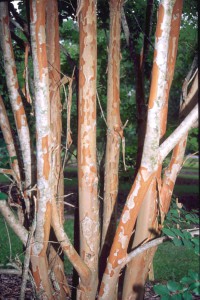
Apalachee Crapemyrtle Bark Photo Credit: UF/IFAS
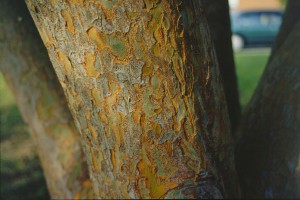
Drake Elm Bark Photo Credit: UF/IFAS
lia, Chinese elm, provide winter interest. “The showy, exfoliating bark reveals random mottled patterns of gray, green, orange and brown, adding great textural and visual interest, especially to its winter silhouette,” writes Ed Gilman, UF/IFAS Horticulturist, in his factsheet on Chinese Elm. This and other tree factsheets are available at http://hort.ifas.ufl.edu/woody. ‘Drake’ and ‘Allee’ are two popular Chinese elm cultivars. Chinese Elm can reach 80 feet in height but is more often seen at 40 to 50 feet with an equal spread.
American Hophornbeam, Ostrya virginiana, is an underused tree that grows to about 50 feet in height. Its grayish bark peels off in longitudinal strips revealing orange patches underneath.
Acer buergeranum or trident maple is a small, underused and hard to find tree. It usually is seen with multiple stems originating fairly low on the trunk giving the small tree a bushy appearance. It has noticeable orange-brown peeling bark.
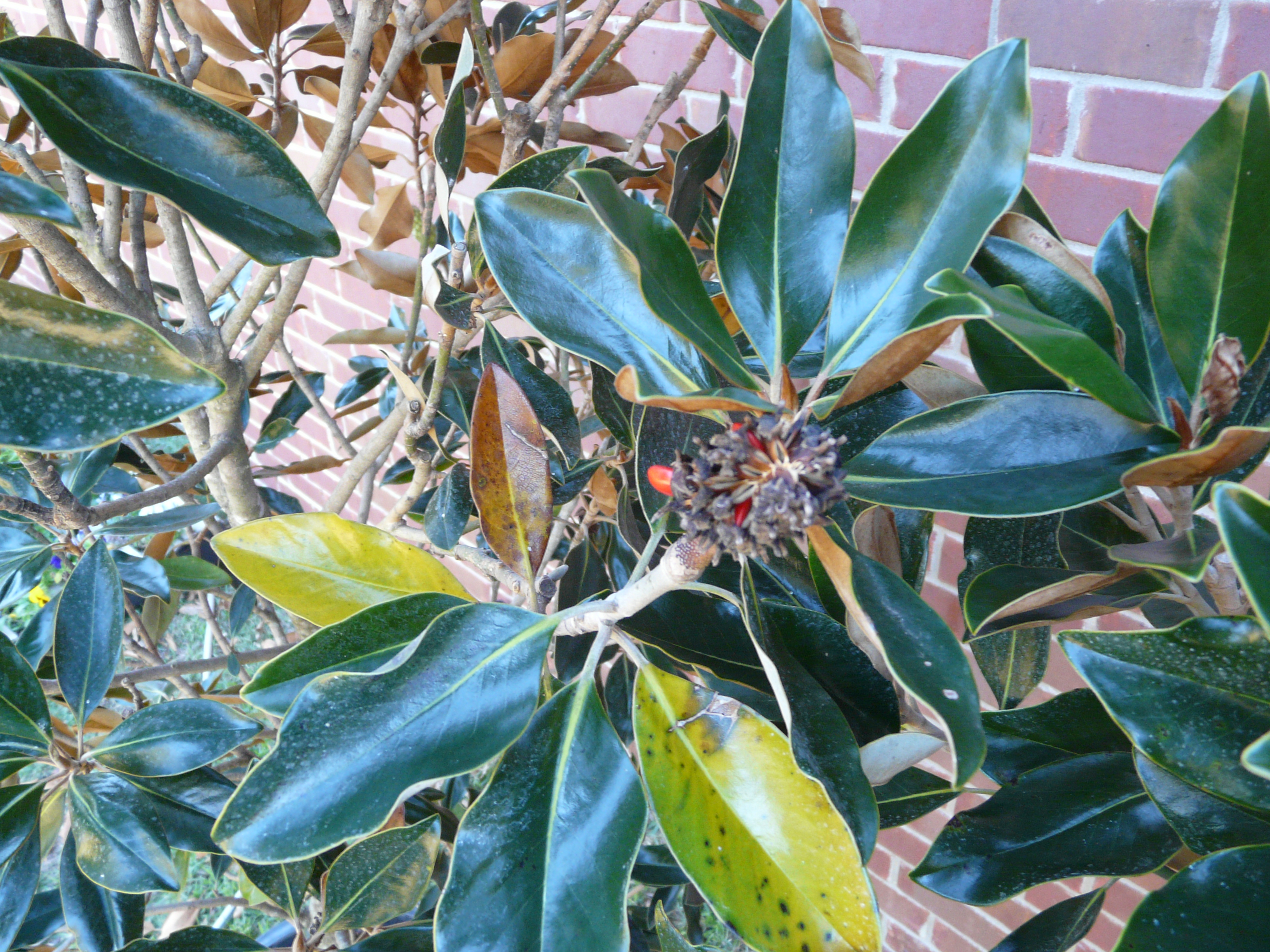
by Larry Williams | Nov 11, 2014
As the season changes, plants change as well. This is true in evergreen and deciduous trees and shrubs as well as our lawn grasses.
The cooler night temperatures and the shorter day length of fall result in changes in the physiology of many of our landscape plants and lawn grasses.
It’s common for azaleas to lose a few leaves now. These are the older leaves on the stem near the center of the plant. They turn reddish or yellow and drop from the plant. This is normal from now until spring. However, if the younger leaves, those nearest the tip of the shoot, turn yellow or brown there is cause for concern. Poor drainage, lack of water or alkaline soils may cause this condition.
Yellow leaves may appear on camellias, gardenias, cherry laurel and oleanders. Again, as with azaleas, these are the older leaves on the stem near the center of the plant. It’s normal for these leaves to drop from the plants now until spring. However, do not confuse scale damage on camellias for normal aging of leaves. Scale insects feed on the lower surface of camellia leaves causing them to become splotched with yellow.
Many of the leaves on sycamore trees have changed from green to brown. Although this phenomenon occurs every year, it’s not caused by a change in day length or temperature. This is not a true seasonal change. It’s the result of insects feeding on the leaves. By the time the damage is visible, there is little that can be done to correct the problem. However, the problem will take care of itself since sycamore trees will soon be dropping their leaves.
Lawn grasses also experience some seasonal changes. The growth rate of lawn grasses slows in the fall. Although this slowdown in growth means less mowing is required, it also means that lawns will not be as attractive as they were during spring and summer. Because of this reduced growth rate, grasses cannot produce enough new leaves to replace the leaves that are dying. The end result is a dull, yellow-green lawn.
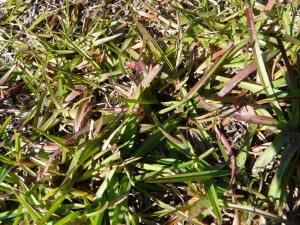
Normal seasonal color change in centipedegrass lawn from green to reddish purple.
Photo by Larry Williams, Okaloosa County Extension

Normal seasonal color change on older ‘Little Gem’ Magnolia leaves. Photo by Larry Williams, Okaloosa County Extension
Numerous reddish-purple blades throughout the lawn may be visible now as well. Cooler temperatures, injury to the leaf blades from foot traffic, mowing equipment, vehicles, etc, can cause this. It also could be caused by lack of potassium or phosphorus but is more likely the result of cooler temperatures, especially if it did not show up until fall.

by Larry Williams | Oct 14, 2014
Goldenrod are easily recognizable this time of year with its showy yellow flowers held high on stems moving back and forth by autumn winds. A field full of these vivid yellow blossoms is a sight to see with a bright blue fall sky as a background. But too often this plant is blamed for the sneezing, runny nose and itchy eyes that many people suffer while goldenrod is blooming.
The common culprit causing these allergy symptoms is ragweed, not goldenrod.
Ragweed blooms at the same time as goldenrod, August to frost.
Ragweed releases its billions of tiny, lightweight pollen grains into the air this time of year. This windborne pollen causes much of the hay fever problems. Goldenrod pollen is too large and heavy and sticky to be windborne. It relies on insects to carry its pollen. I suppose if you put your nose right up into a cluster of goldenrod flowers and took a big sniff, you might be bothered by the pollen. But otherwise, it is not going to get into your nose.
Goldenrod is an innocent bystander as ragweed remains camouflaged releasing its pollen. Ragweed visually blends in with other green plants. Despite the fact that common ragweed, an annual, can grow three to greater than six feet in height, it just does not get your attention. It is quite common along roadsides, vacant lots and abandoned fields. Its inconspicuous flowers start out as green, similar in color to the leaves, turn a yellowish-green and finally dry to a brown color. They are never showy.
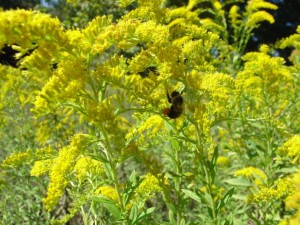
Goldenrod in bloom Photo credit: Larry Williams
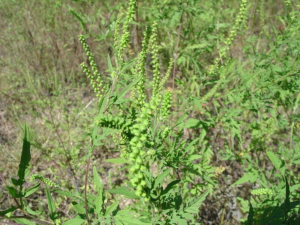
Ragweed in bloom Photo Credit: Larry Williams
Enjoy the bright yellow flowers of goldenrod this fall. But please do not blame them for your allergies.
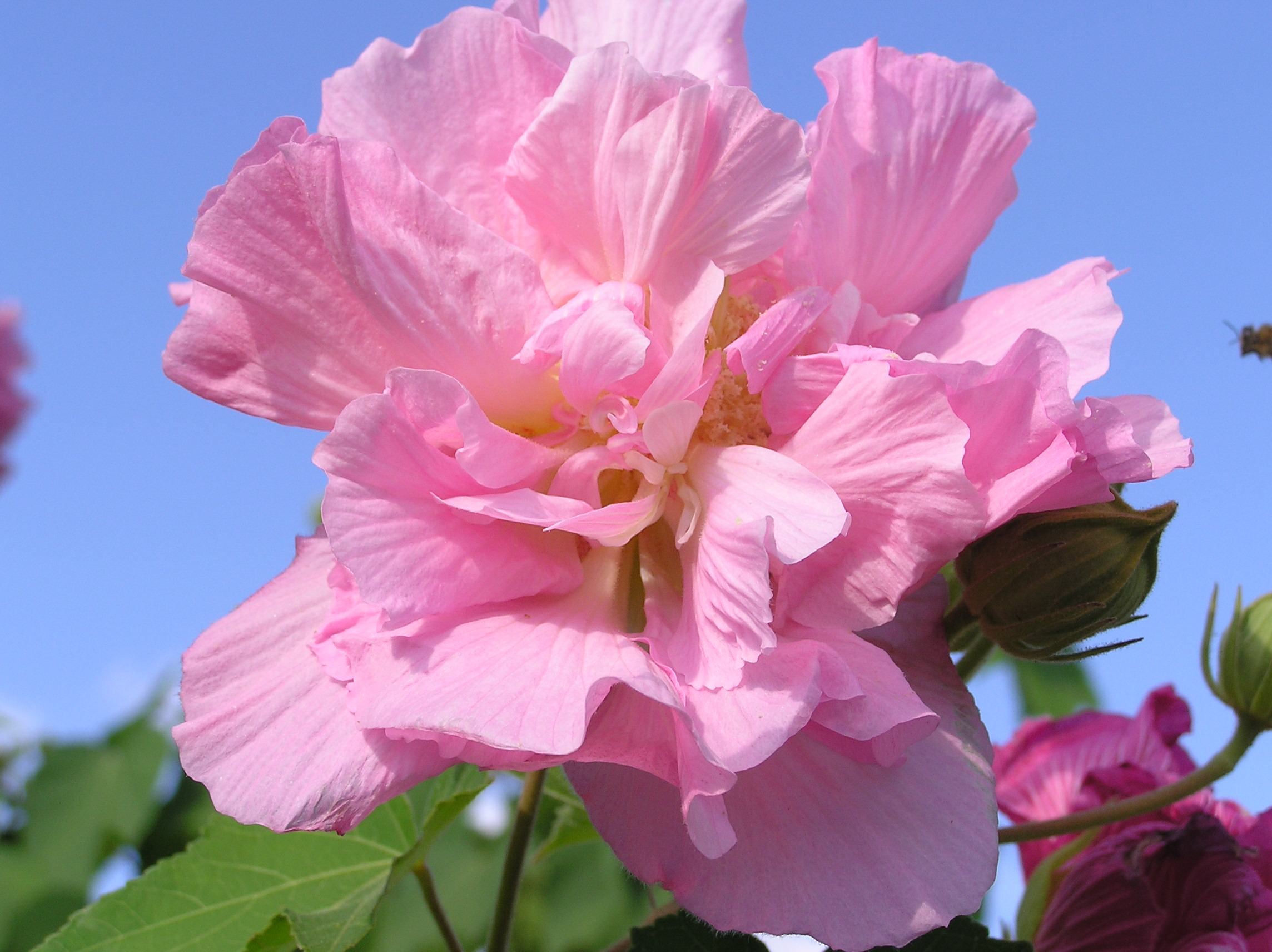
by Larry Williams | Sep 9, 2014
What plant is found mostly in older landscapes but is poorly available in most local nurseries, is closely related to okra and cotton but is called a rose and produces showy fall flowers that turn from white to pink or red? Give up?
The plant is commonly called confederate rose. Some people call it cotton rose. Its botanical name is Hibiscus mutabilis.
Confederate roses usually begin blooming in late summer and continue to flower well into fall.
Even though it’s frequently referred to as confederate rose, it’s not a member of the rose (rosaceae) family. It belongs to the mallow (malvaceae) family, which includes numerous ornamentals, cotton and okra.
It is a true hibiscus. But, unlike many other ornamental hibiscus species, for some reason it is not usually found in most local garden centers. The plant finds its way into other landscapes simply by one gardener sharing a cutting with another gardener.
It’s easy to propagate. New plants can be started in spring from seed or from 8 inch long terminal cuttings taken during spring, summer and early fall. Cuttings can be rooted in a conventional propagation bed or even in a glass of water.
There are several forms of confederate roses. The cultivar known as ‘Rubus’ has deep pink flowers. ‘Plena’ has double white flowers that change to pink or red on the second day. The older, original types have double flowers that open white in the morning and gradually turn pink in the afternoon.
Even though confederate rose is not very impressive during spring and summer with its cotton or okra like leaves, you may find it a worthwhile landscape plant as it produces its large flowers (some up to 6 inches across) in late summer and fall.
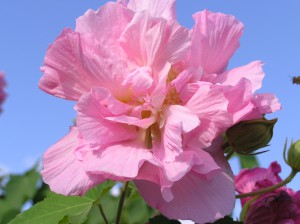
Confederate rose in bloom, Photo Credit: Santa Rosa County Extension
With proper care, a confederate rose should grow into a 15-foot tall bush during a single season. But expect the entire plant to be killed to the ground during the winter. But it usually sprouts rapidly from the crown the following spring. Be careful, too much fertilizer can result in lots of leaves but few blooms.
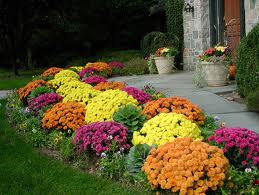
by Larry Williams | Sep 9, 2014
The Emerald Coast Home Show, Health Fair and Business Expo will include lawn and landscape seminars and an information booth hosted by the Okaloosa County Master Gardeners. This event will take place September 13 and 14 at the Emerald Coast Convention Center, 1250 Miracle Strip Parkway in Fort Walton Beach. The horticulture seminars will be provided by the UF/IFAS Extension Office in Okaloosa County.
 A feature of the Emerald Coast Home Show Health Fair and Business Expo will be an information booth hosted by the Okaloosa County Master Gardeners. Master Gardeners will be on hand to answer your gardening questions and to distribute information pertinent to gardening and lawn care on the Gulf Coast.
A feature of the Emerald Coast Home Show Health Fair and Business Expo will be an information booth hosted by the Okaloosa County Master Gardeners. Master Gardeners will be on hand to answer your gardening questions and to distribute information pertinent to gardening and lawn care on the Gulf Coast.
In addition to an information booth hosted by Master Gardeners, free educational seminars will be provided. On Sunday, September 14, I will provide a one hour seminar at 1p.m. entitled “Preparing Your Lawn for Fall and Winter.” This presentation will answer questions concerning preparing your lawn for the dormant period of winter. What’s the truth about” winterizer” fertilizers? Do you need to “winterize” your lawn? How should you water your lawn through the fall and winter? Should you overseed your lawn with annual ryegrass? What should you do about winter weeds in your lawn? What lawn pests are active during fall and winter? Learn the answers to these questions and the truth about winter lawn care for North Florida by attending the Preparing Your Lawn for Fall and Winter seminar.
The complete schedule of free seminars includes the following.
Saturday, September 13
11a.m. Margaret Stewart – Herbs, growing, using and preserving
1p.m. Scott Berry – Orchid basics
3 p.m. Karen Kirk-Williams – Great plants for fall and winter color
Sunday, September 14
1 p.m. Larry Williams – Preparing Your Lawn for Fall and Winter
2 p.m. Marie Harrison – Help! Pollinators in peril
The Emerald Coast Home Show, Health Fair and Business Expo will be open September 13 from 10 a.m. to 6 p.m. and September 14 from 11 a.m. to 4 p.m. and offers free admission, door prizes and giveaway items along with 100 vendors and free health care evaluations.
Visit www.emeraldcoasthomeshow.com for more information.












